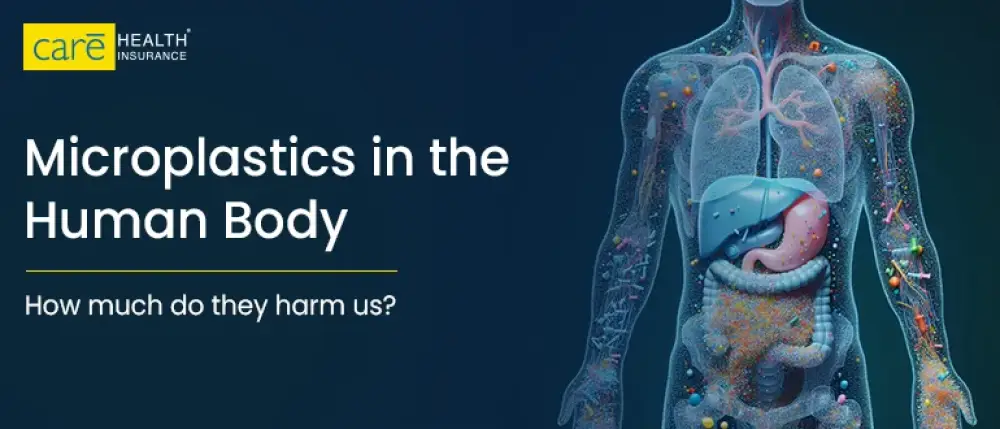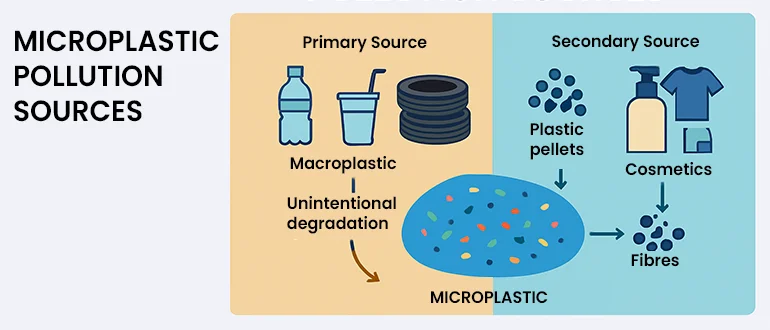Subscribe to get weekly insights
Always stay up to date with our newest articles sent direct to your inbox
Published on 23 May, 2025
Updated on 23 May, 2025
184 Views
5 min Read

Written by Sejal Singhania
Reviewed by Munmi Sharma
favorite0Like
favoriteBe the First to Like
Have you ever reheated food in a plastic container? Or carry a plastic water bottle to work every day?
Let’s be honest. Most of us don’t go a day without plastic. Whether sipping water from a plastic bottle, eating seafood in a beachside cafe, grabbing food in a plastic container, or wearing synthetic fibre cloth, it’s just part of our daily lives.
But here’s something that most of us don’t realise: with every sip, bite, or even breath, you may have been letting tiny bits of plastic, called microplastics, into your body.
So, from now on, when you eat chips from the plastic packet or pour water from the plastic jug, just know that some of that plastic may not stay outside your body. It just goes in.
Microplastics in humans are tiny plastic fragments, less than 5 millimetres in size. They originate from various sources, including breakdown of large plastic products, microbeads in cosmetics, synthetic clothing, and industry processes. Microplastics are found in human blood, lungs, stomach, and even the placenta of unborn babies. In 2022, researchers discovered that microplastics are in human blood and the body.
Microplastics in human blood are delivered through various forms. These microplastics can be so small that they fit on the tip of your finger, while some can't even be seen with the human eye. Microplastics are categorised into two main types:
Microplastics are intentionally produced in small sizes and released directly into the environment. They are often found in products like face scrubs, toothpaste (microbeads), industrial additives, or even microfibers from synthetic clothing, textiles, and fishing nets.
Secondary microplastics are formed when larger plastic items (such as plastic bags, bottles, fishing nets, and other plastic products) break down into smaller pieces due to environmental factors like water, sunlight, and wind. These are smaller fragments (smaller than 5 millimetres), and over time, they fragment into tiny particles.
Both microplastics may end up in the environment and eventually inside us through food, water and even the air we breathe.

It is not necessary to be near a plastic factory or other industrial area to be exposed to microplastics. They are all around us every day, often in ways we are unaware of. It is surprising how easily these small plastics may find their way inside us. Here are some ways through which microplastics enter human blood:
Yes, you’re breathing the microplastic right now. Microplastics are airborne, meaning that tiny plastic particles are suspended in the air and inhaled by us. Depending on their size and shape, microplastics can affect human health by depositing in the respiratory system, including the lungs.
Some personal care products, such as creams, face scrubs, and cosmetics, may contain micro- or nanoplastics. When these products are used and washed, microplastics can infiltrate waterways and eventually be consumed by humans. Microplastic glitter, often made of polyester, is used in cosmetics like eyeshadow and nail polish for an iridescent effect.
Microplastics have been detected in numerous areas within the human body, including reproductive organs. These tiny particles are making their way into places they don't belong. Here are some of the most surprising places microplastics have been discovered:
The fact that microplastics are reaching such critical body parts is deeply concerning. While researchers are still studying their long-term effects, one thing is clear: these tiny particles are not just around us but inside us.
>> Also Read: 5 Serious Health Hazards of Single-Use Plastic in Longer Run
We might not taste or see them, but we consume microplastics daily. Recent studies show the numbers are more alarming than we ever imagined. Here's how much microplastic is entering our bodies per day through all these:
Note: The numbers and estimates related to microplastic intake can vary depending on the study and the specific methods used to measure microplastics. The information provided here reflects the current state of knowledge and research, which is still ongoing.
They may be tiny, but significantly impact our health and body function. Once inside the body, these particles may disrupt, damage and linger. Here are some possible effects of microplastics on human health:
Human exposure to nano- and microplastics may lead to significant health problems, such as inflammatory bowel disease, hormone imbalance, and several types of cancer. Due to harmful substances and persistent inflammation in these microscopic particles, vital organs and long-term health may be in danger. As research continues to uncover the hidden consequences of microplastic exposure, staying safe is more crucial than ever.
That’s where the Care Health Insurance plays a vital role, offering comprehensive health coverage that supports diagnosis, treatment, and hospitalisation expenses for various severe conditions. So, make sure you are always prepared for all the unexpected situations.
While we can’t altogether avoid microplastics, we can take simple steps to reduce our exposure. Some minor changes can help, like:
Small changes like these can go a long way in protecting your health from the hidden risks of microplastics.
Microplastics in humans may be invisible, but their impact on our lives and bodies is real. As science begins to realise the scope of the issues, we must pay attention to our lifestyle, the things we consume, and the materials we surround ourselves with. Every small change, whether carrying a metal bottle or choosing plastic-free packaging, can help reduce your exposure to microplastics.
Disclaimer: The above information is for reference purposes only. Kindly consult your general physician for verified medical advice. The health insurance benefits are subject to policy terms and conditions. Refer to your policy documents for more information.
favoriteBe the First to Like
Thyroid : मामूली नहीं हैं महिलाओं में थायराइड होना, जानें इसके लक्षण और घरेलू उपचार Vipul Tiwary in Diseases
शुगर कंट्रोल कैसे करे? जानें, डायबिटीज में क्या खाना चाहिए Vipul Tiwary in Health & Wellness
हाई ब्लड प्रेशर को तुरंत कंट्रोल कैसे करें? देखें इसके उपाय Vipul Tiwary in Diseases
पैरों में दर्द किस कमी से होता है? जानें, इसके घरेलू इलाज Vipul Tiwary in Health Insurance Articles
Pacemaker Basics: Do You Need One? Leena Khowal in Heart
Puffed Rice: Goodness of a Light, Budget-friendly Snack Yashita Sinha in Diet & Nutrition
Cold Hands? Act Immediately Against Raynaud’s Phenomenon Jagriti Chakraborty in Diseases
Understanding Azotemia: Meaning, Causes, Treatment & ICD 10 Guide Leena Khowal in Diseases
Human exposure to nano- and microplastics may cause significant health problems, such as inflammatory bowel disease, respiratory conditions, and several types of cancer.
Yes, studies have confirmed the presence of microplastics in human blood.
A combination of microscopic examination, spectroscopic methods, and chemical analysis can be used to detect microplastics in human blood.
To reduce microplastics in breast milk, prioritise breastfeeding, use glass or stainless steel bottles and storage containers rather than plastic, and avoid heating breast milk in plastic.
Always stay up to date with our newest articles sent direct to your inbox
Loading...